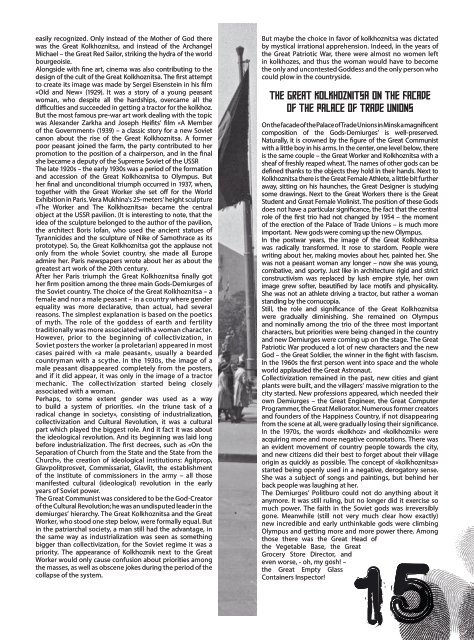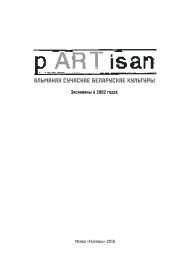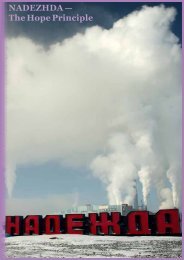pARTisan_32
Create successful ePaper yourself
Turn your PDF publications into a flip-book with our unique Google optimized e-Paper software.
easily recognized. Only instead of the Mother of God there<br />
was the Great Kolkhoznitsa, and instead of the Archangel<br />
Michael – the Great Red Sailor, striking the hydra of the world<br />
bourgeoisie.<br />
Alongside with fine art, cinema was also contributing to the<br />
design of the cult of the Great Kolkhoznitsa. The first attempt<br />
to create its image was made by Sergei Eisenstein in his film<br />
«Old and New» (1929). It was a story of a young peasant<br />
woman, who despite all the hardships, overcame all the<br />
difficulties and succeeded in getting a tractor for the kolkhoz.<br />
But the most famous pre-war art work dealing with the topic<br />
was Alexander Zarkha and Joseph Heifits’ film «A Member<br />
of the Government» (1939) – a classic story for a new Soviet<br />
canon about the rise of the Great Kolkhoznitsa. A former<br />
poor peasant joined the farm, the party contributed to her<br />
promotion to the position of a chairperson, and in the final<br />
she became a deputy of the Supreme Soviet of the USSR<br />
The late 1920s – the early 1930s was a period of the formation<br />
and accession of the Great Kolkhoznitsa to Olympus. But<br />
her final and unconditional triumph occurred in 1937, when,<br />
together with the Great Worker she set off for the World<br />
Exhibition in Paris. Vera Mukhina's 25-meters’ height sculpture<br />
«The Worker and The Kolkhoznitsa» became the central<br />
object at the USSR pavilion. (It is interesting to note, that the<br />
idea of the sculpture belonged to the author of the pavilion,<br />
the architect Boris Iofan, who used the ancient statues of<br />
Tyrannicides and the sculpture of Nike of Samothrace as its<br />
prototype). So, the Great Kolkhoznitsa got the applause not<br />
only from the whole Soviet country, she made all Europe<br />
admire her. Paris newspapers wrote about her as about the<br />
greatest art work of the 20th century.<br />
After her Paris triumph the Great Kolkhoznitsa finally got<br />
her firm position among the three main Gods-Demiurges of<br />
the Soviet country. The choice of the Great Kolkhoznitsa – a<br />
female and nor a male peasant – in a country where gender<br />
equality was more declarative, than actual, had several<br />
reasons. The simplest explanation is based on the poetics<br />
of myth. The role of the goddess of earth and fertility<br />
traditionally was more associated with a woman character.<br />
However, prior to the beginning of collectivization, in<br />
Soviet posters the worker (a proletarian) appeared in most<br />
cases paired with «a male peasant», usually a bearded<br />
countryman with a scythe. In the 1930s, the image of a<br />
male peasant disappeared completely from the posters,<br />
and if it did appear, it was only in the image of a tractor<br />
mechanic. The collectivization started being closely<br />
associated with a woman.<br />
Perhaps, to some extent gender was used as a way<br />
to build a system of priorities. «In the triune task of a<br />
radical change in society», consisting of industrialization,<br />
collectivization and Cultural Revolution, it was a cultural<br />
part which played the biggest role. And it fact it was about<br />
the ideological revolution. And its beginning was laid long<br />
before industrialization. The first decrees, such as «On the<br />
Separation of Church from the State and the State from the<br />
Church», the creation of ideological institutions: Agitprop,<br />
Glavpolitprosvet, Commissariat, Glavlit, the establishment<br />
of the institute of commissioners in the army – all those<br />
manifested cultural (ideological) revolution in the early<br />
years of Soviet power.<br />
The Great Communist was considered to be the God-Creator<br />
of the Cultural Revolution; he was an undisputed leader in the<br />
demiurges’ hierarchy. The Great Kolkhoznitsa and the Great<br />
Worker, who stood one step below, were formally equal. But<br />
in the patriarchal society, a man still had the advantage, in<br />
the same way as industrialization was seen as something<br />
bigger than collectivization, for the Soviet regime it was a<br />
priority. The appearance of Kolkhoznik next to the Great<br />
Worker would only cause confusion about priorities among<br />
the masses, as well as obscene jokes during the period of the<br />
collapse of the system.<br />
But maybe the choice in favor of kolkhoznitsa was dictated<br />
by mystical irrational apprehension. Indeed, in the years of<br />
the Great Patriotic War, there were almost no women left<br />
in kolkhozes, and thus the woman would have to become<br />
the only and uncontested Goddess and the only person who<br />
could plow in the countryside.<br />
The Great Kolkhoznitsa on the Facade<br />
of the Palace of Trade Unions<br />
On the facade of the Palace of Trade Unions in Minsk a magnificent<br />
composition of the Gods-Demiurges’ is well-preserved.<br />
Naturally, it is crowned by the figure of the Great Communist<br />
with a little boy in his arms. In the center, one level below, there<br />
is the same couple – the Great Worker and Kolkhoznitsa with a<br />
sheaf of freshly reaped wheat. The names of other gods can be<br />
defined thanks to the objects they hold in their hands. Next to<br />
Kolkhoznitsa there is the Great Female Athlete, a little bit further<br />
away, sitting on his haunches, the Great Designer is studying<br />
some drawings. Next to the Great Workers there is the Great<br />
Student and Great Female Violinist. The position of these Gods<br />
does not have a particular significance, the fact that the central<br />
role of the first trio had not changed by 1954 – the moment<br />
of the erection of the Palace of Trade Unions – is much more<br />
important. New gods were coming up the new Olympus.<br />
In the postwar years, the image of the Great Kolkhoznitsa<br />
was radically transformed. It rose to stardom. People were<br />
writing about her, making movies about her, painted her. She<br />
was not a peasant woman any longer – now she was young,<br />
combative, and sporty. Just like in architecture rigid and strict<br />
constructivism was replaced by lush empire style, her own<br />
image grew softer, beautified by lace motifs and physicality.<br />
She was not an athlete driving a tractor, but rather a woman<br />
standing by the cornucopia.<br />
Still, the role and significance of the Great Kolkhoznitsa<br />
were gradually diminishing. She remained on Olympus<br />
and nominally among the trio of the three most important<br />
characters, but priorities were being changed in the country<br />
and new Demiurges were coming up on the stage. The Great<br />
Patriotic War produced a lot of new characters and the new<br />
God – the Great Soldier, the winner in the fight with fascism.<br />
In the 1960s the first person went into space and the whole<br />
world applauded the Great Astronaut.<br />
Collectivization remained in the past, new cities and giant<br />
plants were built, and the villagers’ massive migration to the<br />
city started. New professions appeared, which needed their<br />
own Demiurges – the Great Engineer, the Great Computer<br />
Programmer, the Great Meliorator. Numerous former creators<br />
and founders of the Happiness Country, if not disappearing<br />
from the scene at all, were gradually losing their significance.<br />
In the 1970s, the words «kolkhoz» and «kolkhoznik» were<br />
acquiring more and more negative connotations. There was<br />
an evident movement of country people towards the city,<br />
and new citizens did their best to forget about their village<br />
origin as quickly as possible. The concept of «kolkhoznitsa»<br />
started being openly used in a negative, derogatory sense.<br />
She was a subject of songs and paintings, but behind her<br />
back people was laughing at her.<br />
The Demiurges’ Politburo could not do anything about it<br />
anymore. It was still ruling, but no longer did it exercise so<br />
much power. The faith in the Soviet gods was irreversibly<br />
gone. Meanwhile (still not very much clear how exactly)<br />
new incredible and early unthinkable gods were climbing<br />
Olympus and getting more and more power there. Among<br />
those there was the Great Head of<br />
the Vegetable Base, the Great<br />
Grocery Store Director, and<br />
even worse, - oh, my gosh! –<br />
the Great Empty Glass<br />
Containers Inspector!<br />
15





